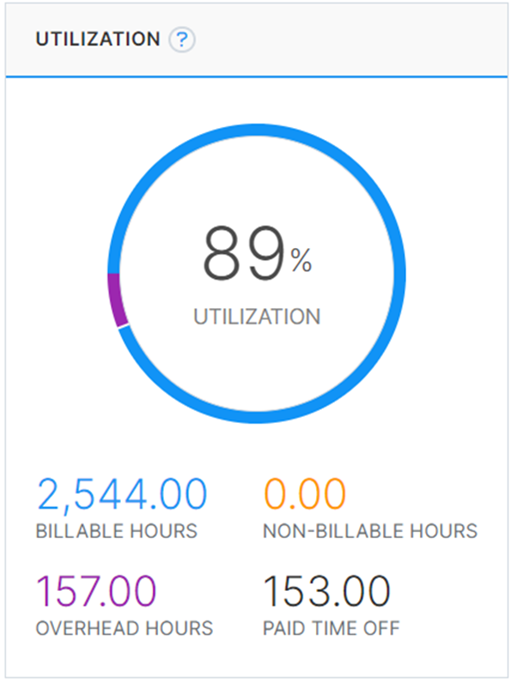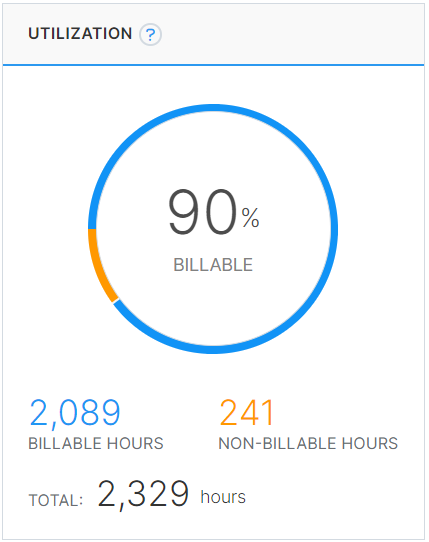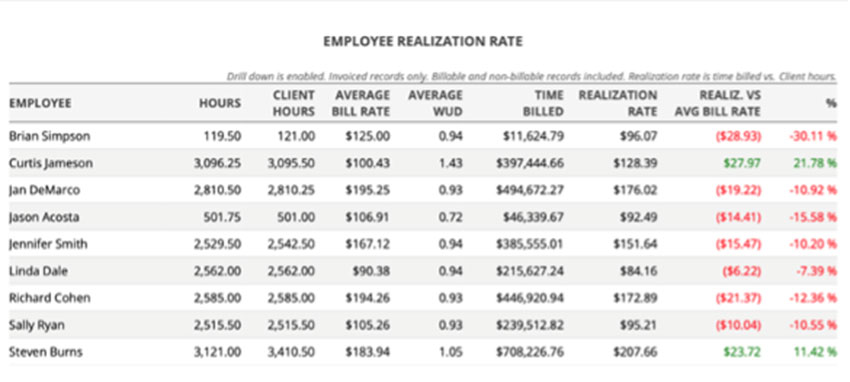11 Top Key Performance Indicators (KPIs) of Successful Firms
KPI #1 – UTILIZATION
Determining the utilization rate of employees in a firm is a fundamental measurement that has powerful effects on how a business is run. It is defined as the amount of an employee's available time that's used for productive, billable work, (i.e., direct project work). It is always expressed as a percentage of the total available time, such that a utilization rate of 100 percent means that all hours are billable, and zero percent means that no hours are billed to a client.

Utilization is defined as the amount of an employee's available time that's used for productive, billable work, expressed as a percentage.

The first way to look at utilization is to apply it to individual employees. If we assume a 40-hour work week and look at it for 52 weeks, then the total annual available time for an employee can be presumed to be 2,544 hours. Most firms offer paid time off (PTO) such as vacation, holidays, sick time, etc. which is obviously not billable, but still paid to the employee. If an employee has fifteen days or 120 hours of PTO in a year then they only have the potential of 2,089 hours or about 90 percent of their time actually available for direct billing (assuming no overtime). Further, if the employee charges time to non-billable things such as office meetings, professional development, etc., then the number of direct hours is further decreased by these indirect activities. If that amounted to around 100 hours for the year (two hours per week) then the 90 percent utilization rate in our example would decrease to around 89 percent. In general terms, that is considered a pretty good individual utilization rate.
Not all employees should be expected to have the same utilization rate since not all employees may have the same amount of paid time off. Further, some employees have greater responsibilities that aren’t billable associated with marketing, office administration, or management for example. Optimal utilization rates need to account for each employee’s necessary or expected non-billable time. Setting realistic utilization rates influences resource management since they help in forecasting true available time for projects and resource optimization.
Another way to look at utilization rate is for a group of employees, such as a project team or studio group. When using proper time tracking software, it’s possible to see not only who spent time on billable work and how much, but how much time within the group was allocated to non-billable, indirect time. Tracking the utilization rate of a group of employees this way is helpful in a variety of ways including the calculation of a billing rate to the client.
Utilization rates can also be looked at on the project level. When this KPI is used to look at every hour that is spent working on a project, it differentiates between those that were billable and those, which for whatever reason, were not justifiably billable. Ideally, close to 100 percent of the direct time is billable, but if the hours exceed the budgeted fee or if additional administrative time is needed, then those hours necessarily become indirect expenses. This illustrates the reason why this KPI is such an important metric since it measures the billing efficiency. Most architects appreciate the benefits of efficiency when it comes to building and construction. In the same way, managing a firm and projects that are likewise efficient should always be a goal.
It’s important to remember that the best way to monitor and respond to utilization rates is in real time which means time reporting must be efficient. Manual analyses waste time and delay understanding since they require gathering information from various sources and compiling it into a report. If this is the case, by the time the information is known, it’s generally too late to do anything about it. Computerized time sheets can overcome this.
KPI #2 – REALIZATION
Just because an employee is highly utilized doesn’t necessarily mean that profitability is assured. To determine that, the KPI of actual dollar realization is needed. A Realization rate is calculable not as a percentage, like Utilization, but as currency. It’s the actual invoiced value of every hour that was worked by an employee on a project. In other words, it takes Utilization from a percentage and translates it into the value of an employee on an hourly basis.

Realization is the notion that revenue can only be recognized once the services have been delivered and earned. Learn more about the difference between utilization and realization rate.
Realization is important because on certain projects - or even on certain phases of certain projects - an employee may not be billing out fully for their hourly services. This might be because the project is part of a fixed fee arrangement based on the percentage of completion during the invoice period. In those situations, the hours worked don’t directly correlate into revenue based on hourly rates. In other cases, people are being utilized but the manager isn’t justified in billing for all the hours worked during that period for any variety of reasons. Good management software understands these types of situations and can still report out the revenue earned and adjust it on an hourly basis.
Understanding what causes Realization is critical to the health of a firm. It could be that a project is poorly managed, such as when a manager doesn’t give an employee sufficient information, but they proceed to do the work and then discover it needs to be redone. Alternatively, an employee may not be competent in the work being asked of them and it takes a lot longer to complete it. In this case the manager needs to write off some of those hours or if it is limited by a fixed fee, it gets written down by default.
All this feeds into fee negotiation at the outset of a project. A principal who negotiates a contract may not allocate enough fee to allow the team to properly execute the work. Conversely, the Realization rate could show up as very high because the principal may have negotiated fees for the projects that are more than sufficient to execute the work. Hence, this particular KPI is directly tied to negotiating skills at the outset as well as the effective management and competency of the project team.










